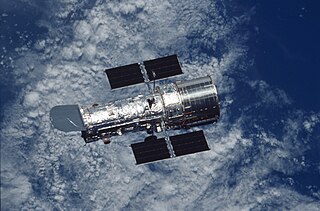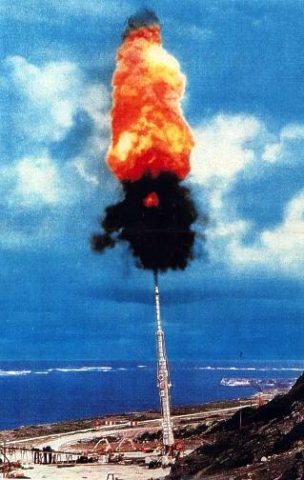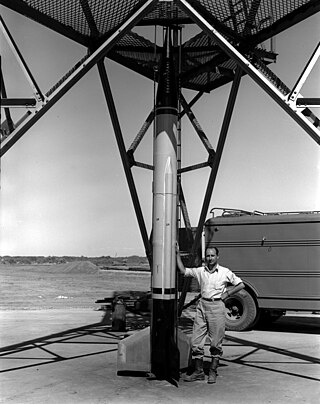
Konstantin Eduardovich Tsiolkovsky was a Russian rocket scientist who pioneered astronautics. Along with Hermann Oberth and Robert H. Goddard, he is one of the pioneers of space flight and the founding father of modern rocketry and astronautics. His works later inspired Wernher von Braun and leading Soviet rocket engineers Sergei Korolev and Valentin Glushko, who contributed to the success of the Soviet space program. Tsiolkovsky spent most of his life in a log house on the outskirts of Kaluga, about 200 km (120 mi) southwest of Moscow. A recluse by nature, his unusual habits made him seem bizarre to his fellow townsfolk.

A rocket is a vehicle that uses jet propulsion to accelerate without using any surrounding air. A rocket engine produces thrust by reaction to exhaust expelled at high speed. Rocket engines work entirely from propellant carried within the vehicle; therefore a rocket can fly in the vacuum of space. Rockets work more efficiently in a vacuum and incur a loss of thrust due to the opposing pressure of the atmosphere.

This article gives a concise timeline of rocket and missile technology.

Spaceflight is an application of astronautics to fly objects, usually spacecraft, into or through outer space, either with or without humans on board. Most spaceflight is uncrewed and conducted mainly with spacecraft such as satellites in orbit around Earth, but also includes space probes for flights beyond Earth orbit. Such spaceflight operate either by telerobotic or autonomous control. The more complex human spaceflight has been pursued soon after the first orbital satellites and has reached the Moon and permanent human presence in space around Earth, particularly with the use of space stations. Human spaceflight programs include the Soyuz, Shenzhou, the past Apollo Moon landing and the Space Shuttle programs. Other current spaceflight are conducted to the International Space Station and to China's Tiangong Space Station.

Hermann Julius Oberth was an Austro-Hungarian-born German physicist and rocket pioneer of Transylvanian Saxon descent. He is considered one of the founding fathers of rocketry and astronautics, along with Robert Esnault-Pelterie, Konstantin Tsiolkovsky, Robert H. Goddard and Herman Potočnik. Oberth supported Nazi Germany's war effort and received the War Merit Cross in 1943.

Astronautics is the practice of sending spacecraft beyond Earth's atmosphere into outer space. Spaceflight is one of its main applications and space science is its overarching field.

Robert Hutchings Goddard was an American engineer, professor, physicist, and inventor who is credited with creating and building the world's first liquid-fueled rocket, which was successfully launched on March 16, 1926. By 1915 his pioneering work had dramatically improved the efficiency of the solid-fueled rocket, signaling the era of the modern rocket and innovation. He and his team launched 34 rockets between 1926 and 1941, achieving altitudes as high as 2.6 km (1.6 mi) and speeds as fast as 885 km/h (550 mph).

Project HARP, short for High Altitude Research Project, was a joint venture of the United States Department of Defense and Canada's Department of National Defence created with the goal of studying ballistics of re-entry vehicles and collecting upper atmospheric data for research. Unlike conventional space launching methods that rely on rockets, HARP instead used very large guns to fire projectiles into the atmosphere at extremely high speeds.

Georg Arthur Constantin Friedrich Zander, was a Baltic German pioneer of rocketry and spaceflight in the Russian Empire and the Soviet Union. He designed the first liquid-fueled rocket to be launched in the Soviet Union, GIRD-X, and made many important theoretical contributions to the road to space.

A sub-orbital spaceflight is a spaceflight in which the spacecraft reaches outer space, but its trajectory intersects the surface of the gravitating body from which it was launched. Hence, it will not complete one orbital revolution, will not become an artificial satellite nor will it reach escape velocity.

The NASA X-43 was an experimental unmanned hypersonic aircraft with multiple planned scale variations meant to test various aspects of hypersonic flight. It was part of the X-plane series and specifically of NASA's Hyper-X program developed in the late 1990s. It set several airspeed records for jet aircraft. The X-43 is the fastest jet-powered aircraft on record at approximately Mach 9.6.

In astrodynamics and aerospace, a delta-v budget is an estimate of the total change in velocity (delta-v) required for a space mission. It is calculated as the sum of the delta-v required to perform each propulsive maneuver needed during the mission. As input to the Tsiolkovsky rocket equation, it determines how much propellant is required for a vehicle of given empty mass and propulsion system.

A launch vehicle is typically a rocket-powered vehicle designed to carry a payload from Earth's surface or lower atmosphere to outer space. The most common form is the ballistic missile-shaped multistage rocket, but the term is more general and also encompasses vehicles like the Space Shuttle. Most launch vehicles operate from a launch pad, supported by a launch control center and systems such as vehicle assembly and fueling. Launch vehicles are engineered with advanced aerodynamics and technologies, which contribute to high operating costs.

Space launch is the earliest part of a flight that reaches space. Space launch involves liftoff, when a rocket or other space launch vehicle leaves the ground, floating ship or midair aircraft at the start of a flight. Liftoff is of two main types: rocket launch, and non-rocket spacelaunch.

The WAC Corporal was the first sounding rocket developed in the United States and the first vehicle to achieve hypersonic speeds. It was an offshoot of the Corporal program, that was started by a partnership between the United States Army Ordnance Corps and the California Institute of Technology in June 1944 with the ultimate goal of developing a military ballistic missile.

Project Hermes was a missile research program run by the Ordnance Corps of the United States Army from November 15, 1944, to December 31, 1954, in response to Germany's rocket attacks in Europe during World War II. The program was to determine the missile needs of army field forces. A research and development partnership between the Ordnance Corps and General Electric started November 20, 1944 and resulted in the "development of long-range missiles that could be used against both ground targets and high-altitude aircraft."

The GAM-63 RASCAL was a supersonic air-to-surface missile that was developed by the Bell Aircraft Company. The RASCAL was the United States Air Force's first nuclear armed standoff missile. The RASCAL was initially designated the ASM-A-2, then re-designated the B-63 in 1951 and finally re-designated the GAM-63 in 1955. The name RASCAL was the acronym for RAdar SCAnning Link, the missile's guidance system. The RASCAL project was cancelled in September 1958.

Non-rocket spacelaunch refers to theoretical concepts for launch into space where much of the speed and altitude needed to achieve orbit is provided by a propulsion technique that is not subject to the limits of the rocket equation. Although all space launches to date have been rockets, a number of alternatives to rockets have been proposed. In some systems, such as a combination launch system, skyhook, rocket sled launch, rockoon, or air launch, a portion of the total delta-v may be provided, either directly or indirectly, by using rocket propulsion.

The first rockets were used as propulsion systems for arrows, and may have appeared as early as the 10th century in Song dynasty China. However more solid documentary evidence does not appear until the 13th century. The technology probably spread across Eurasia in the wake of the Mongol invasions of the mid-13th century. Usage of rockets as weapons before modern rocketry is attested to in China, Korea, India, and Europe. One of the first recorded rocket launchers is the "wasp nest" fire arrow launcher produced by the Ming dynasty in 1380. In Europe rockets were also used in the same year at the Battle of Chioggia. The Joseon kingdom of Korea used a type of mobile multiple rocket launcher known as the "Munjong Hwacha" by 1451.

Space research is scientific study carried out in outer space, and by studying outer space. From the use of space technology to the observable universe, space research is a wide research field. Earth science, materials science, biology, medicine, and physics all apply to the space research environment. The term includes scientific payloads at any altitude from deep space to low Earth orbit, extended to include sounding rocket research in the upper atmosphere, and high-altitude balloons.



















